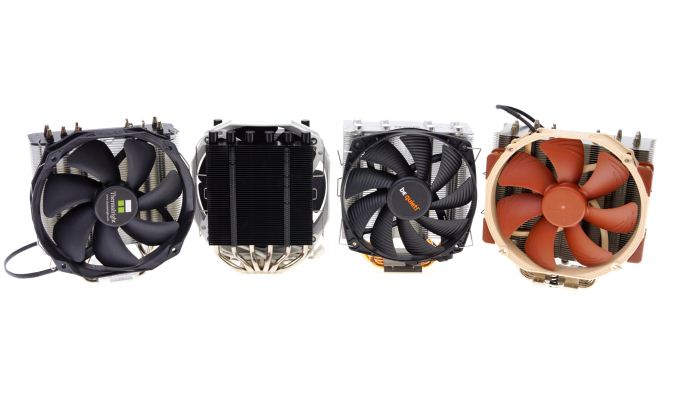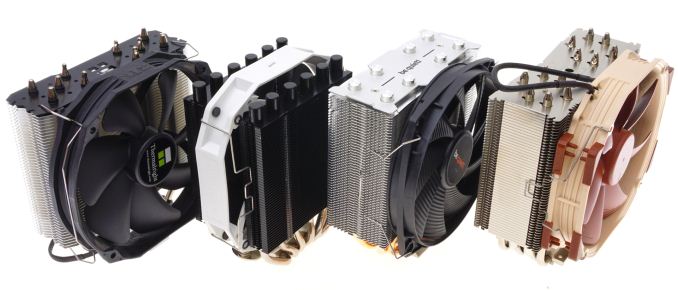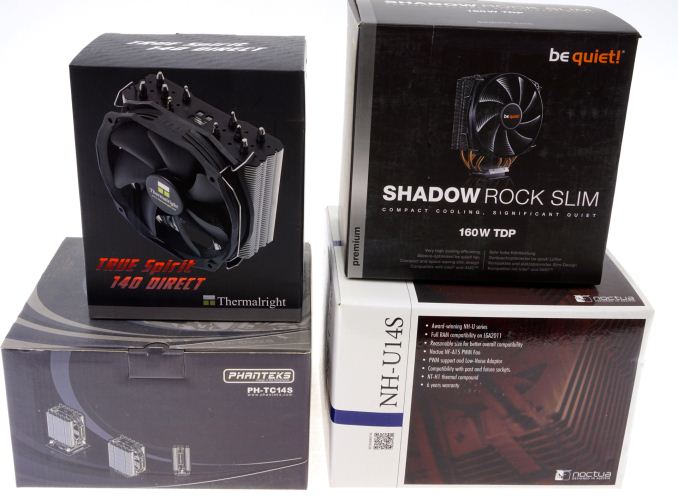The 140mm Slim Tower CPU Cooler Roundup: Thin & Light Done Just Right
by E. Fylladitakis on May 24, 2017 8:00 AM EST- Posted in
- Cases/Cooling/PSUs
- be quiet!
- Noctua
- Phanteks
- Cooler
- Thermalright

A standard cooler is supplied with nearly all retail boxed CPUs, which guarantees adequate cooling performance under normal operating conditions. Enthusiasts however are rarely satisfied with the performance of stock CPU coolers, seeking either better overall performance or lower noise levels. This is especially true for those who are planning to overclock their systems, as the supplied coolers usually don't have the extra performance required for handling overdriven processors.
However, the selection of a CPU cooler is a complicated matter. It depends on the available space, the user’s needs and wants, as well as on the available budget. For example, some users might require high performance but low profile coolers due to limited space, while others may have spacious cases and high enough budgets to afford a huge dual-tower cooler.
In today's review we will be having a look at some of the most popular single tower 140 mm CPU coolers currently available. Considering that height usually is the primary concern with CPU coolers, single tower 140 mm coolers virtually have the same space requirements as the dual tower 140 mm coolers do. Their distinct advantages however are much lower weight and significantly more competitive pricing. This makes them ideal for users that do have the available space, but do not require the performance of a dual-tower behemoth or move their system often, in which case the cooler’s weight becomes a major safety concern.
 Thermalright True 140 Direct, Phanteks PH-TC14S, Be Quiet! Shadow Rock Slim, & Noctua NH-U14S
Thermalright True 140 Direct, Phanteks PH-TC14S, Be Quiet! Shadow Rock Slim, & Noctua NH-U14S
The four coolers that we are taking a look at in this roundup review are the: Noctua NH-U14S, Phanteks PH-TC14S, Thermalright True Spirit 140 Direct, and the Be Quiet! Shadow Rock Slim. All four of these coolers have similar space requirements and pricing, but they are certainly not created equal. We will have a closer look at their individual strengths and weaknesses in the following pages of this review.
| 140mm Tower CPU Coolers | ||||
| Product | Fan(s) | Fan Speed (RPM) | Height (mm/in) | Current Retail Pricing |
| Noctua NH-U14S | 1 × 140 mm | 1500 RPM | 165 mm / 6.5” | $65 |
| Phanteks PH-TC14S | 1 × 140 mm | 1300 RPM | 160 mm / 6.3” | $50 |
| ThermalRight True Spirit 140 Direct | 1 × 140 mm | 1600 RPM | 161 mm / 6.34” | $47 |
| Be Quiet! Shadow Rock Slim | 1 × 140 mm | 1400 RPM | 161 mm / 6.34” | $50 |











74 Comments
View All Comments
guidryp - Wednesday, May 24, 2017 - link
IMO, it looks like the Thermalright is the the winner. It's the least expensive, and up to 150 watts, it keeps the lowest temperature. How many CPUs pull over 150 watts? Especially in real world workloads, not torture testing??JoeyJoJo123 - Wednesday, May 24, 2017 - link
That would seem to be the case here, yes. Performs as well as the Noctua (better than the Noctua at low loads and nearly equal at high loads), while being physically smaller, and cheaper, too.The black and silver finish is relatively attractive, too, but appearances are subjective anyways.
A5 - Wednesday, May 24, 2017 - link
Agreed, and I own the Noctua.I've had Thermalright products in the past and they were excellent as well.
ShieTar - Wednesday, May 24, 2017 - link
That only remains true if the CPU produces power over the same area as the thermal cartridge used in the test. The problem, specifically with Intels latest 4-Cores, is that they generate 100W on a much smaller area. Then the overall cooling capability and the vertical thermal resistance of the cooler become less relevant, and the lateral thermal resistance of the cooler base-plate becomes increasingly critical. That is why an i7-7700K will run much hotter than older CPUs with the same TDP, but much more die area.JoeyJoJo123 - Wednesday, May 24, 2017 - link
You're not wrong, but there's more to that story.It's also partially attributable to Intel's usage of poor TIM between the die and the integrated heatspreader, rather than their older usage of fluxless solder.
Intel's newer chips (due to smaller die sizes and poorer thermal interface for the integrated heatspreader) means that by the time the heat meets the heatsink vs integrated heatspreader contact area, it's not being dissipated as efficiently as older CPU models.
guidryp - Wednesday, May 24, 2017 - link
I think you have the situation backwards. The way the Thermalright excels at lower temperatures and it's direct heatpipe design indicate it has superb transfer from the socket.It only falls behind later when when the smaller heatsink array can't dissipate it as quickly.
Eri Hyva - Wednesday, May 24, 2017 - link
Please, add a test with 9 volts.Arbie - Wednesday, May 24, 2017 - link
Other sites reviewing coolers (eg X-Bit Labs R.I.P.) have found ways to plot cooling ability vs noise level. That makes it much easier to evaluate and choose the best one. IIRC one site even got cost into the same picture. In any case, leaving the reader to separately juggle delta-T and dBA is weak.Galcobar - Thursday, May 25, 2017 - link
Gold standard for standardized testing the efficiency of noise to cooling is Silent PC Review.Unfortunately, the site suffered a serious lack of ad revenue and seemed to go into the media death spiral of lack of readership>lack of revenue>lack of content>lack of readership. Hasn't been a posting since August.
snarfbot - Wednesday, May 24, 2017 - link
Well the article measures perf as shipped which while good is not apples to apples as they all use diff fans. They should be measured separately with the same fan installed into each to take fan speed, voltage and noise out of the equation.